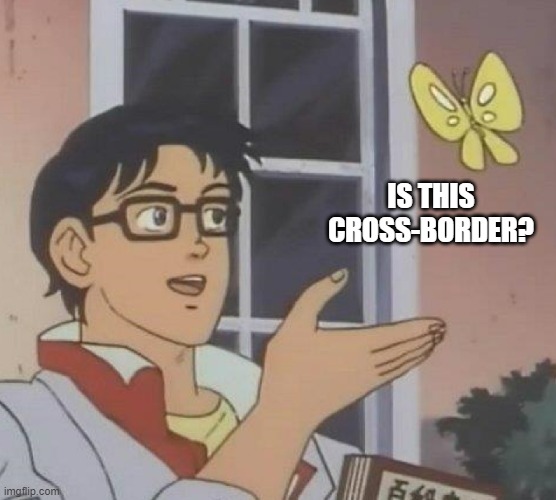With the talk of PayPal issuing a stablecoin, the idea of cheapening cross-border payments is bound to come up again. But it’s not really about crossing borders, it’s a little more complex than that. Here’s how to think about payments and border crossing.
Actually, border crossing is a confusing way of thinking about payments, and sometimes leads us to the wrong place. For example if an American, while on holiday in Italy, uses Venmo to send $20 to her friend who is on holiday in Singapore, is that cross-border? There is certainly value crossing the many borders from Italy to Singapore, but the actors are using one single currency (USD) and Venmo did not charge for the transaction – it was “free” for the customers.
Similarly when I send USDC or ETH to someone who lives in a different country (is this cross-border?), it costs the gas fee, but that’s it. In this respect, Ethereum is a global bank where everyone banks, and transactions are just book transfers (debits and credits, or plusses and minuses) between accounts. There are no borders to cross.
Typically if both people use the same service provider (bank, wallet, fintech etc), then a transaction tends to be cheaper and faster than if they use different service providers, because the service provider just has to take some money away from one account and add it to the other: a book transfer. This database entry is entirely in the control of one single actor, and is easy.
Payments that involve currency conversion (“FX”) are typically more expensive for the end user than payments in a single currency. This is because it’s easier for a service provider to embed fees into the transaction without the user noticing. If I send $20 and you receive $19, it’s really obvious to us both that there was a $1 fee (whether we’re in different countries or not). If I send $20 and you receive €16 then, damn, now we need to Google the FX rate to see how much value has disappeared. Service providers (banks, wallets, fintechs, card companies etc) love transactions involving FX for this reason. It is not the fact that value appears to cross a border, it’s the opacity around the FX that’s lucrative.
In fact, a border doesn’t even need to be crossed: if your bank allows currency conversion, just try it: convert some money from currency A to B and back to A again. You’ll have paid fees, without crossing any borders!
It can get more complicated though. Consider a cross-border single currency payment. For instance, if I hold USD in a bank account in Singapore and I want to send it as USD, to land in USD, to a tour operator who has a USD account in a Vietnamese bank, then there will be the sender’s bank and the receiver’s bank, and typically two other banks involved (the American banks where the Asian banks hold their USD), and all four banks may take fees along the way. This will be more expensive, and slow, as many databases need to be updated in a coordinated way.
This is also the case if we are both in the same country and a border hasn’t been crossed! If we are both in Singapore and I want to send you USD, from my USD account at my Singapore bank, to your USD account at your Singapore bank, there may still be up to 4 banks involved, each taking fees (my bank, your bank, my bank’s USD bank, your bank’s USD bank).
So when people talk about cross-border payments, they probably actually mean FX or payments in non-domestic currencies. It’s important to get into the details. Do not accept “Person A wants to send money to person B”! Prefer “Person A wants to send EUR from their bank in Italy to person B who wants to receive USD in their bank in Japan”.
For any cross-border scenario, I like to ask questions like: What’s the sender’s currency? Which country is their bank in? What’s the receiver’s currency, which country is their bank in? Is there FX? Who does the FX? Are the currencies domestic or foreign to the banks? How many service providers are involved? If it’s a non-domestic currency, where do the banks bank?
You’ll get a lot of clarity if you ask these as a starting point.
Note: If the above was confusing, with banks having accounts at other banks (why the complexity?!), here’s a simple way to think about it. Imagine you’re starting a brand new bank. You’re going to need a database to track your customers’ deposits, and you’ll need a way to receive and store their digital money when they start wiring deposits to you, so you open an account with your local central bank (ideally, or any local bank if not). This gives you domestic capabilities including transfers in and out. Next, you want to offer foreign currencies, so what do you do? You open bank accounts at foreign banks – at an American bank for USD, at an Australian bank for AUD, etc. These foreign banks let you store those currencies (on behalf of your customers), and indirectly access those foreign payment networks. These banks are called your correspondent banks.




